Whether you call them Low FODMAP Pork Dumplings or pot stickers, this classic Chinese appetizer CAN fit into your low FODMAP lifestyle. Purchased thin wheat flour wrappers are filled with a flavorful pork filling, featuring soy sauce, scallion greens, fresh ginger and toasted sesame oil. Once they are cooked we serve them up with a tangy dipping sauce.
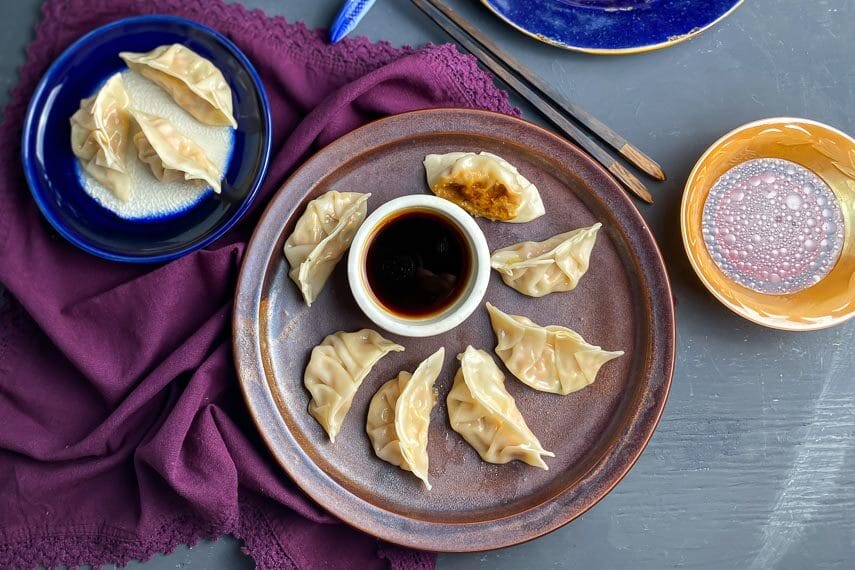
Are you surprised to see a dumpling recipe that uses traditional wheat–based dumpling wrappers/skins? We take you through what you need to know below, step-by-step.
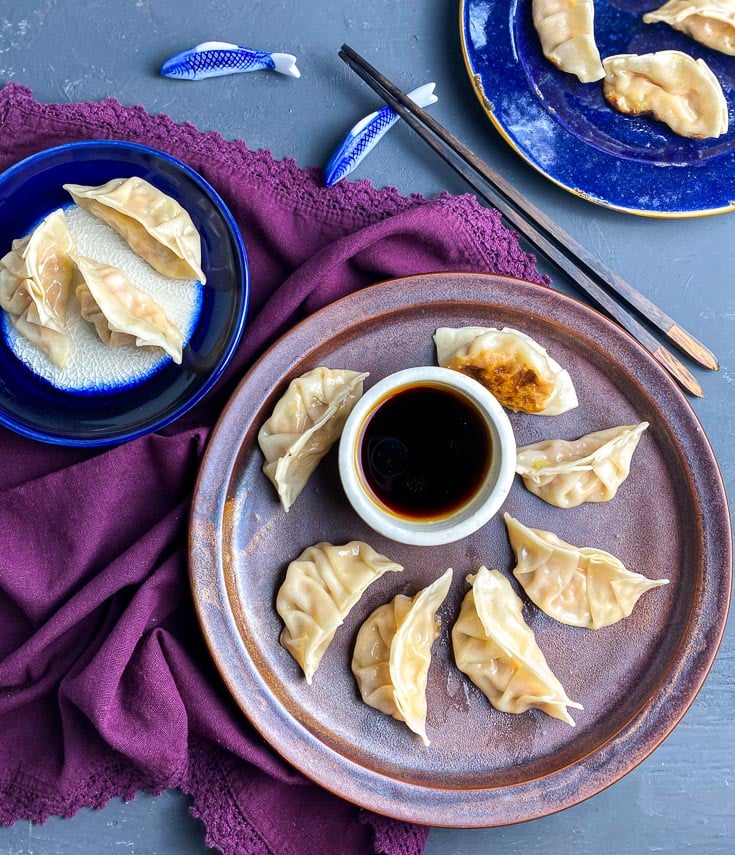
Frequently Asked Questions
Pork dumplings are a classic Chinese and Chinese-American recipe, found on many restaurant menus listed as an appetizer. But, FYI, they are so delicious we have been known to eat them as the main event. They can be boiled, steamed or fried. The wrapper is round and is wheat-flour based.
Yes, dumpling skins are low FODMAP. The low FODMAP diet is neither wheat-free nor gluten-free and “wonton” wrappers have been lab tested by Monash University and 8 wrappers (64 g, uncooked) are a low FODMAP serving. Whether they are round or square, called wonton skins, dumpling skins or gyoza, they are all made from the same ingredients and can be considered equivalent, from a FODMAP perspective.
For this recipe you need the round ones. They can be found in the refrigerator or freezer section of Asian stores or well-stocked supermarkets. In many of our supermarkets they are in the produce section.
Soy sauce is low FODMAP. We have an entire article that you can read that will give you the details. Soy can be confusing as some soy products are low FODMAP and some are not.
When it comes to choosing soy sauce, there is a huge difference between naturally brewed and chemically produced. The latter is so acrid and unpalatable, we never recommend it, and in fact it can ruin a dish. We are huge fans of San-J and have used this brand for years. Then, to make it even better, they put several of their products through lab testing and certification. They are certified by FODMAP Friendly.
Even within a brand, there are choices to be made. Please note that I call for low sodium.
If you use a higher sodium soy sauce, or a chemically made soy sauce, the flavor of this dish will not work. Period.
Buy the San J Low Sodium Gluten-Free Soy Sauce for this dish. It is my go-to soy sauce, so you will find it asked for in the great majority of our recipes calling for soy sauce.
It is very easy to make the perfect sauce in which to dip your dumplings. I tried several different approaches and was thrilled when the easiest prevailed as the tastiest. It is all about the salty/sweet/sour balance. You can add chili oil for heat as well, but I think the salty soy sauce, the sour vinegar and a tiny bit of sweetness from sugar are key.
It is as simple as whisking ingredients together in a bowl. And because it is so easy, you can make it last minute, or make it way ahead and have it in the fridge, waiting for you.
You might note that I have called the inclusion of the FreeFod Garlic Replacer in the dipping sauce to be optional. This is because I know that not all of you will have it on hand and the sauce does work without it. That said, you should have it in your pantry and there is no substitute for it. It is the most direct way to incorporate garlic flavor into your cooking without oil or additional salt. I highly recommend this product.
We knew this would be a question, so we made a short video, found below. It is much easier to show than to explain – and if you can have the written explanation to refer to along with the video, all the better. But seriously, don’t sweat it. They don’t have to look fancy or pretty. As long as you get the two halves of the dumpling wrapper stuck together with some water and a bit of pressure, you’ll be fine.
Yes, you can steam or boil the dumplings. We like to pan fry them, then steam them, for a combo approach. Our directions below explain how to cook them 3 different ways.
Yes, you can freeze our Low FODMAP Pork Dumplings. You can steam, boil or pan-fry from frozen, no defrosting needed. The cooking times will just be longer; use visual cues. The dough of the wrappers will take on a somewhat translucent look when they are done.
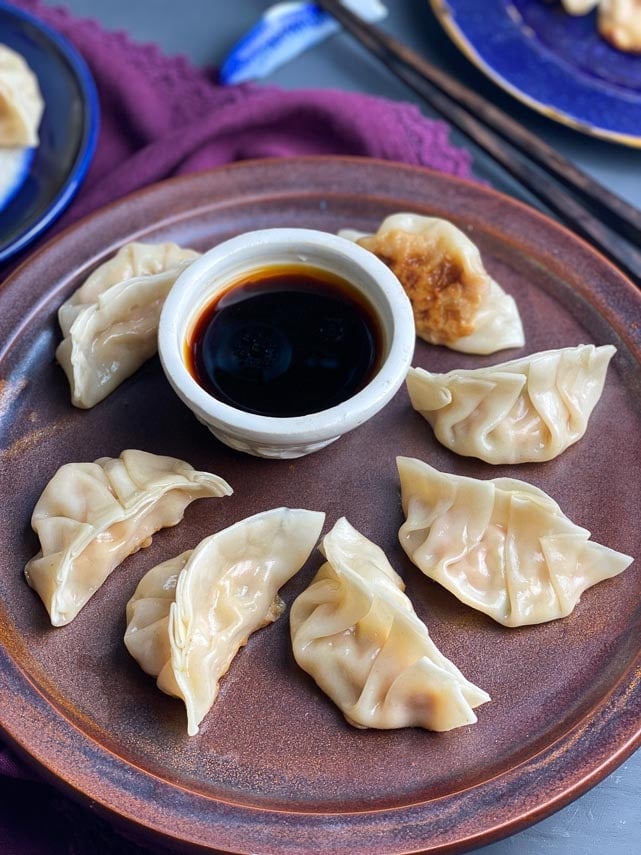
How To Make Low FODMAP Pork Dumplings
For The Dipping Sauce: In a small nonreactive bowl whisk together the rice vinegar, soy sauce and FreeFod Garlic Replacer and sugar, if using.
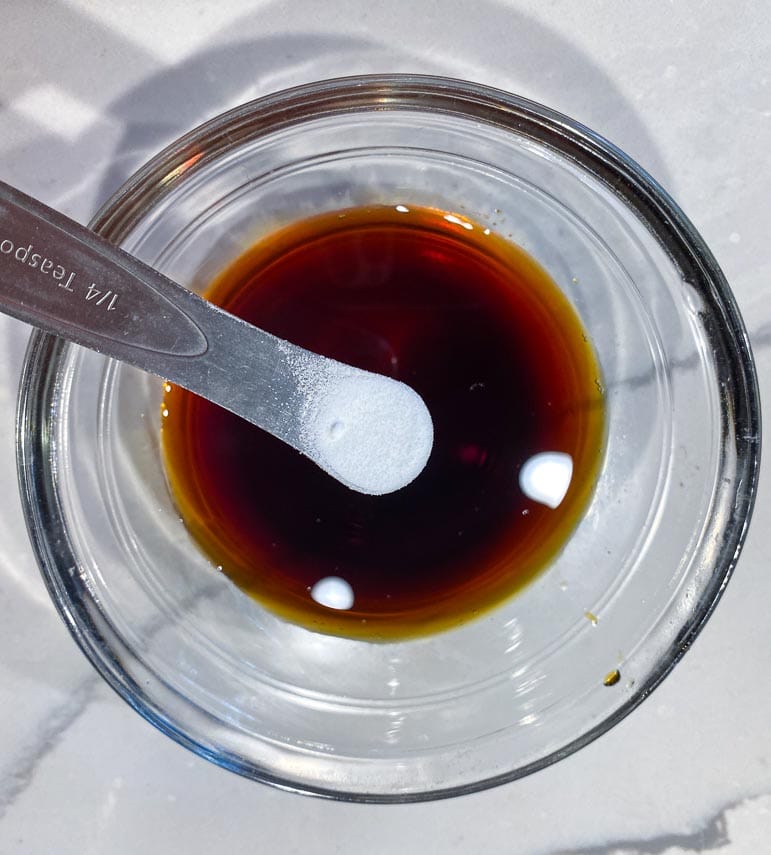
Once the Replacer and sugar are dissolved, whisk in the toasted sesame oil and chili oil to taste, again, if using. Taste and adjust amounts of ingredients as desired. Sauce is ready to use or may be stored at room temperature in an airtight container overnight.
For The Dumplings: In a large bowl, combine the pork, cabbage, scallion greens, soy sauce, toasted sesame oil, ginger, salt and egg until very well mixed. Use your hands to make sure the mixture is very well combined.
Create your dumpling making station with your filling, water and dumpling skins nearby. Have a damp cloth over the dumpling skins (or plastic wrap) to keep them from drying out as you make your dumplings.
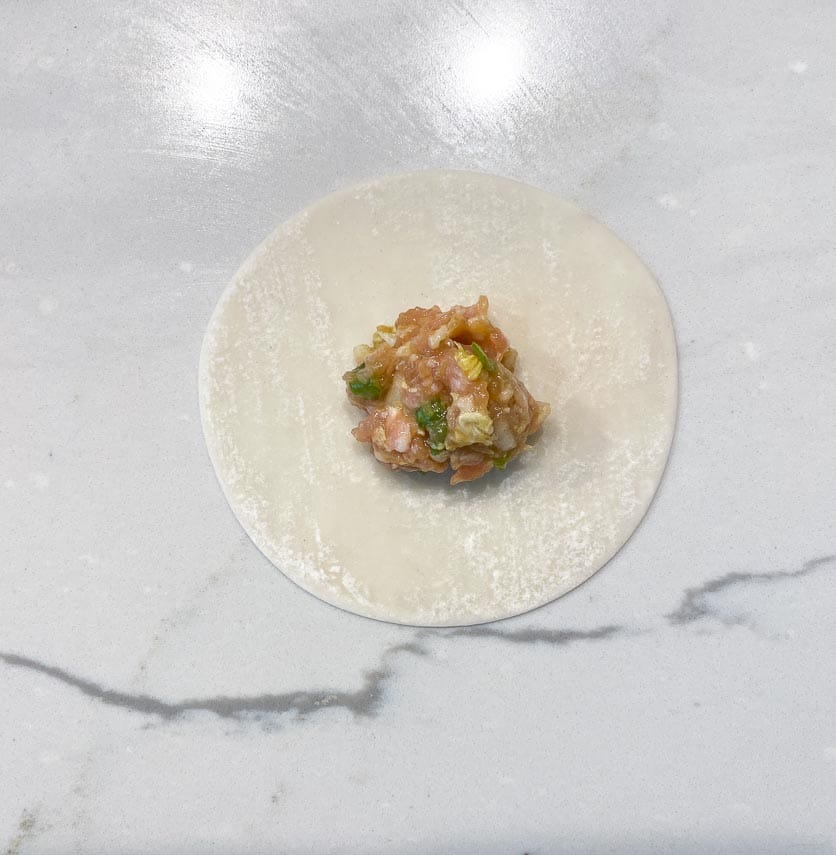
Place about 2 teaspoons of pork filling onto the center each wonton skin. Moisten edges of dumpling skin with water. You can use your fingertip dipped in water, or use a small brush.
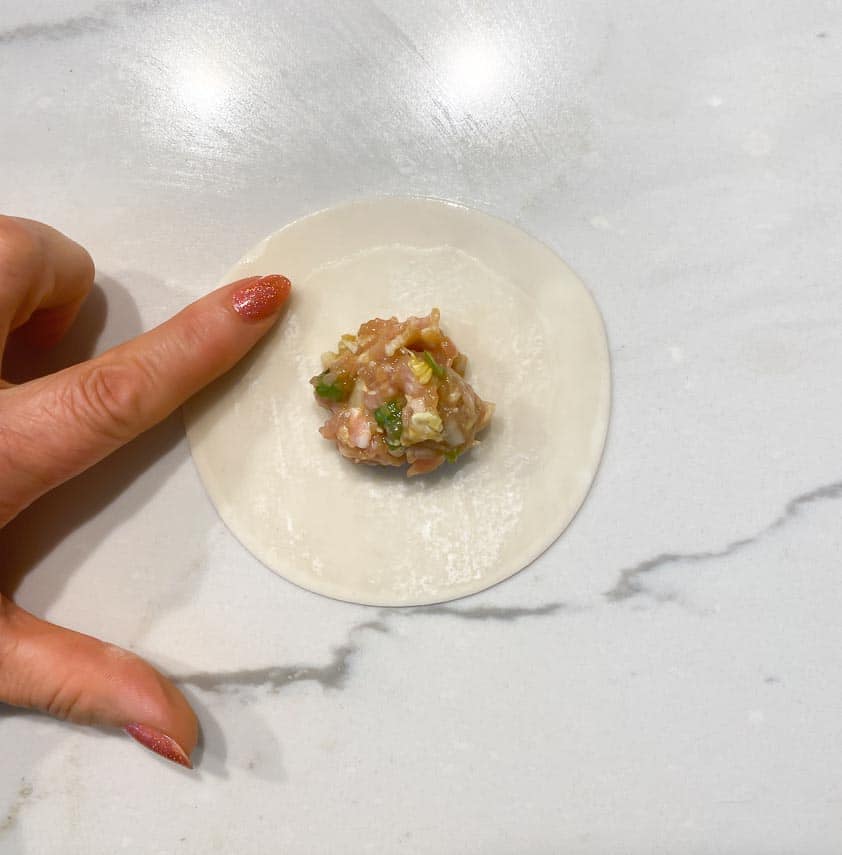
Fold dumpling skin edges over to form a half-moon shape. You can either press firmly to seal, or gently pleat. NOTE: You do not have to get fancy and pleat! You CAN simply press the edges together and be done with it. Easy! The most important thing is that the two halves are sealed well together, pleats or not.
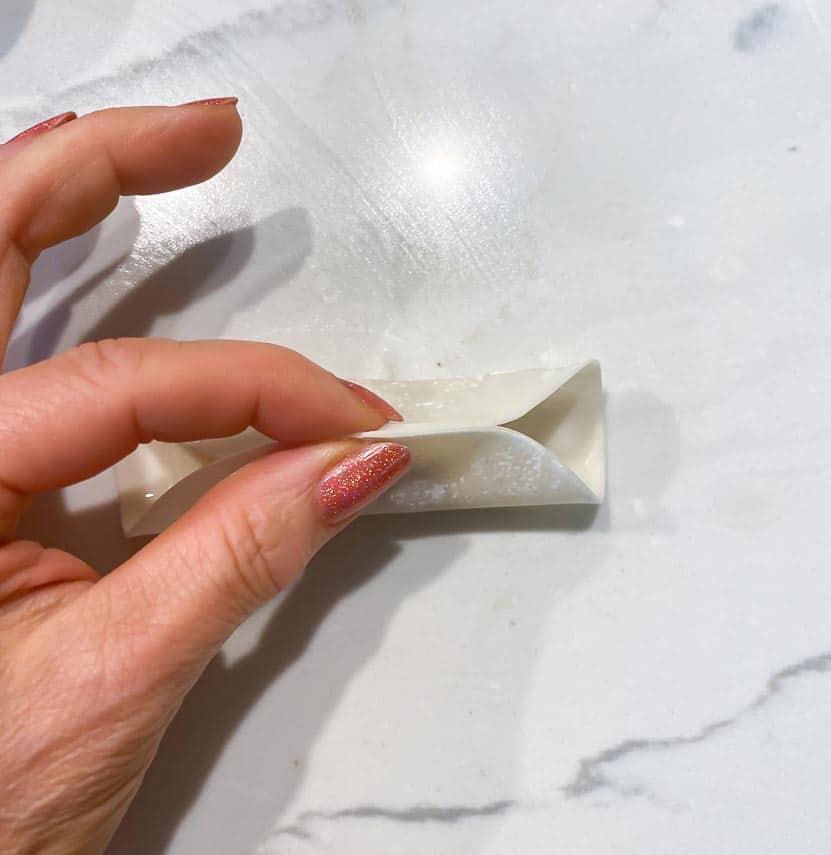
If you want to pleat, there are many approaches to take; I will describe two.
The One Directional Pleat: This is where pleats go all the way across the crescent shape, folding and pleating in one direction. Hold the dumpling in front of you with the two halves folded to make a taco shape, but in this case you have not pinched and sealed any parts yet. Then, focusing on the side of the dumpling near you, begin on the left side and pinch the very edge together.
Then make one small pleat, folding the wrapper onto itself towards the left. Continue moving across the wrapper, keep making pleats, all facing that left direction.
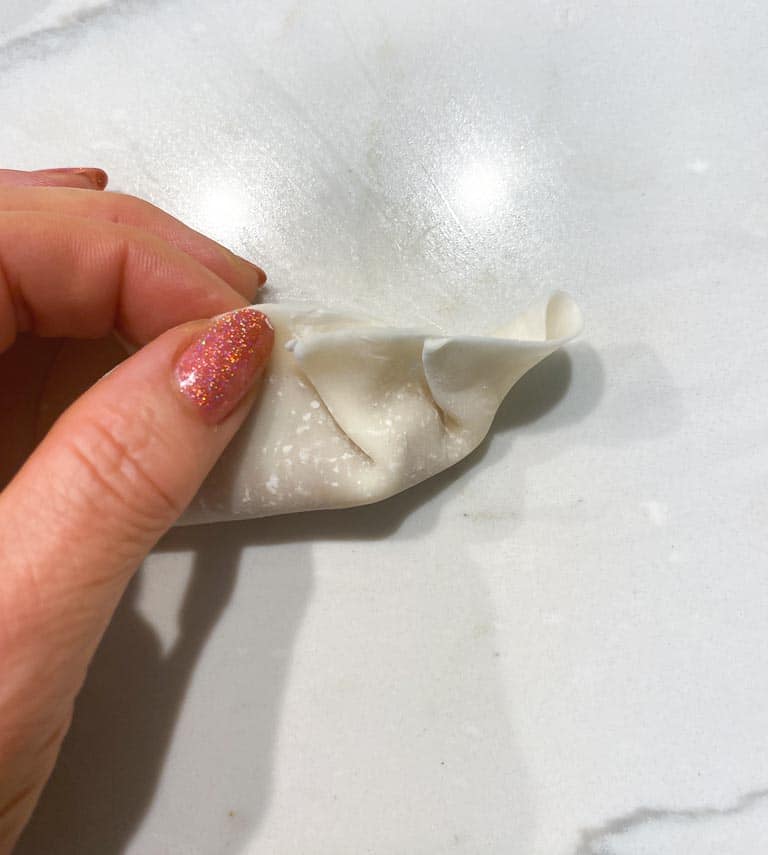
Note that some folks like to pleat to the right, and also some folks find it easier to pleat the edge that is on the backside of the dumpling. Do whatever you need to do that feels easiest. You will probably get about 5 or 6 pleats total. Make sure to pinch the ends closed when finished pleating.
The Two Directional Pleat: This is where pleats fold in from the left and the right for a symmetrical, but more complex look. Hold the dumpling in front of you with the two halves folded to make a taco shape and pinch the center together to create stability.
Then, focusing on the side of the dumpling near you, begin to the left of the center pinch and create pleats folding and pleating towards the middle and keep working your pleats moving towards the left end of the dumpling. When you get to the left end you can simply pinch together or make one last tiny pleat. Repeat by making pleats on the right side, going towards the center. You will get 3 or 4 pleats on each side. Give all the pleats one last firm squeeze.
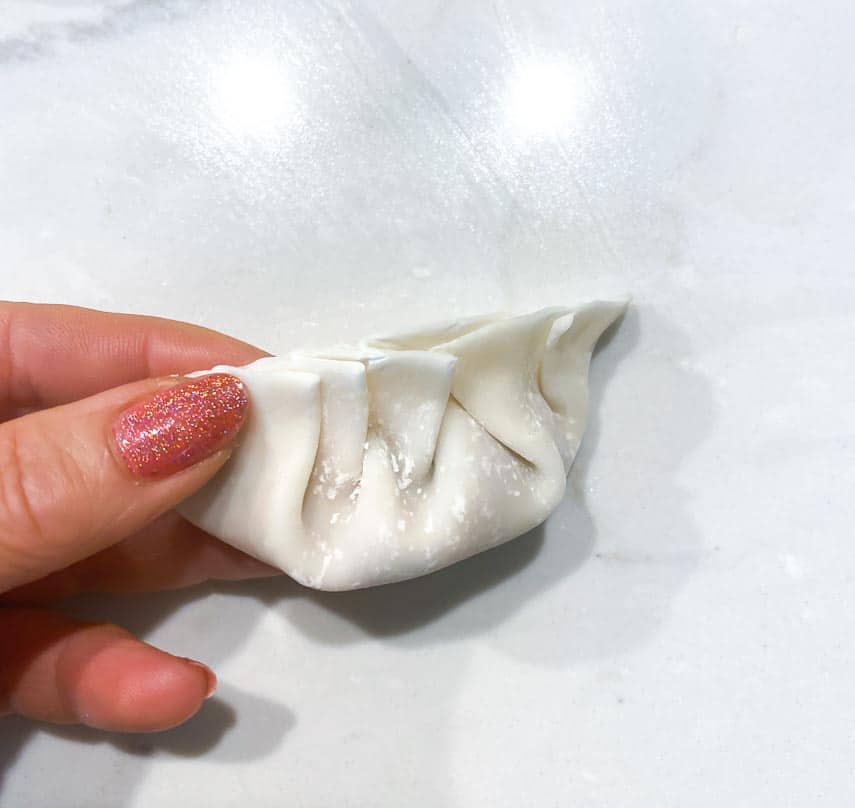
When your dumplings are all filled you can place them on a pan in a single layer and freeze. Once frozen they can be popped into zip-top bags or airtight containers and frozen for up to 2 months.
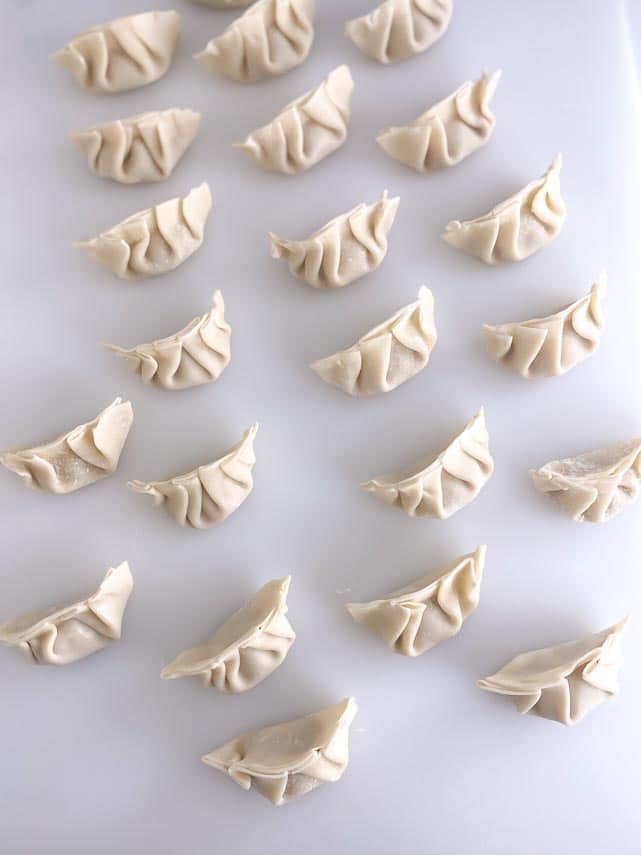
You can proceed and cook them as described below from frozen; the cooking time might just be a tad longer.
You can boil, steam or pan-fry the dumplings.
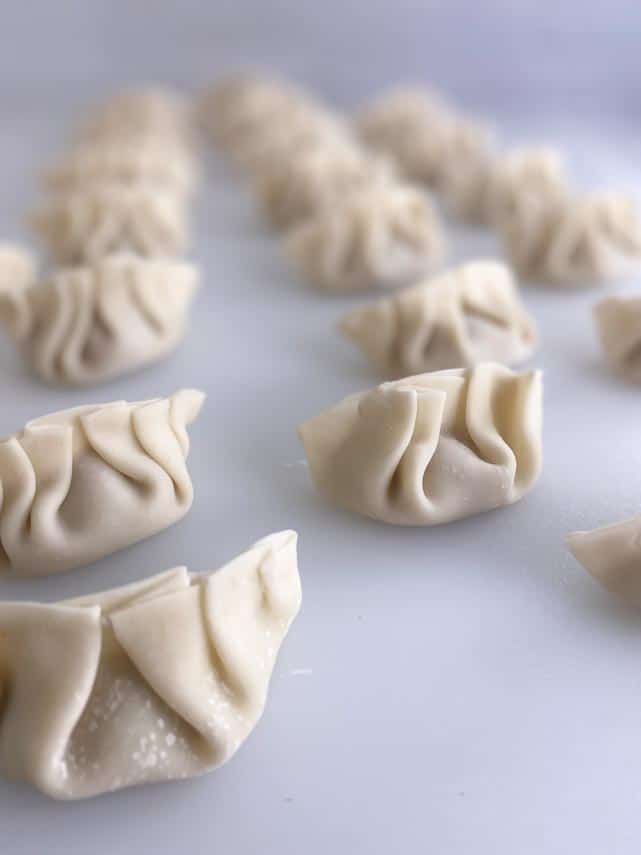
To Steam Dumplings: Set up a covered bamboo steamer over boiling water. Cut a piece of parchment paper to fit, then line the inside of the steamer. You can also lay a large cabbage leaf down instead of the paper. Place dumplings on paper/cabbage leaf. They are easy to pick up and handle.
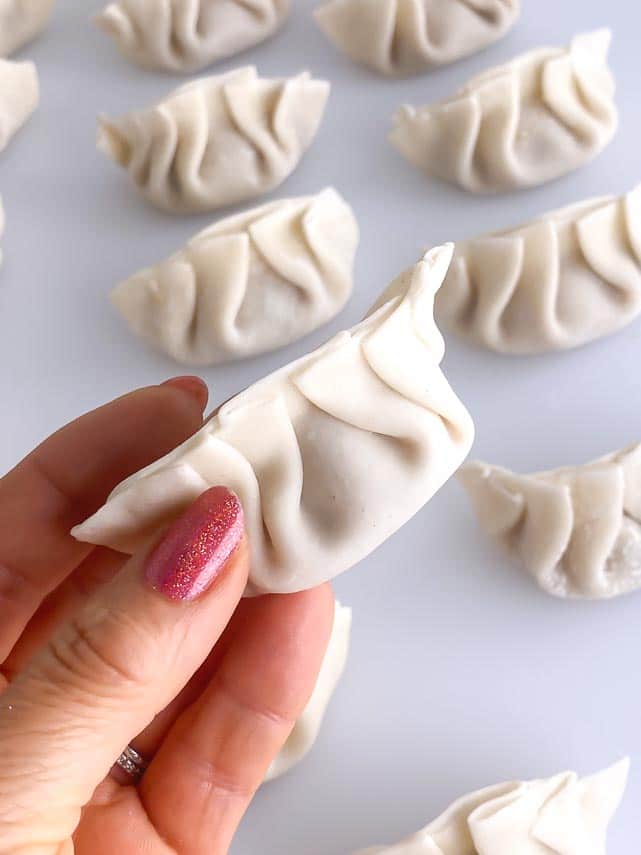
Steam for about 10 minutes or until they look a bit translucent. Serve immediately with Dipping Sauce.
To Boil Dumplings: Bring a pot of water to a boil, drop the dumplings in, allowing room for them to move around, and cook for about 3 minutes or until translucent and they float to the top. Drain, dab on a layer of paper towels to absorb excess water. Serve immediately with Dipping Sauce.
To Pan Fry Dumplings: Add enough vegetable oil to just cover and create a thin film over the bottom of a skillet (I have successfully used nonstick, triple-ply stainless and cast-iron).
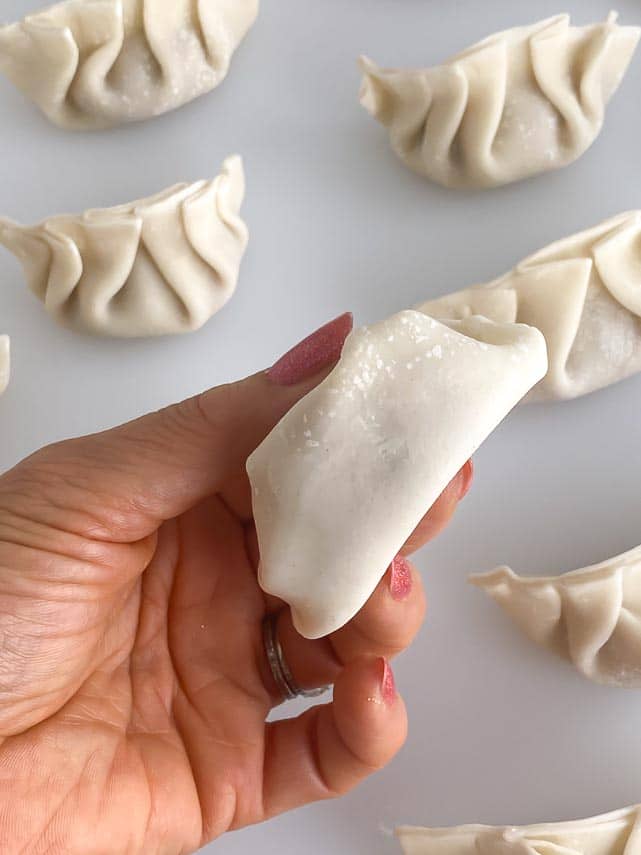
Heat over medium heat until oil is shimmering then add as many dumplings – fat, broad side down – as will fit allowing ample room between.
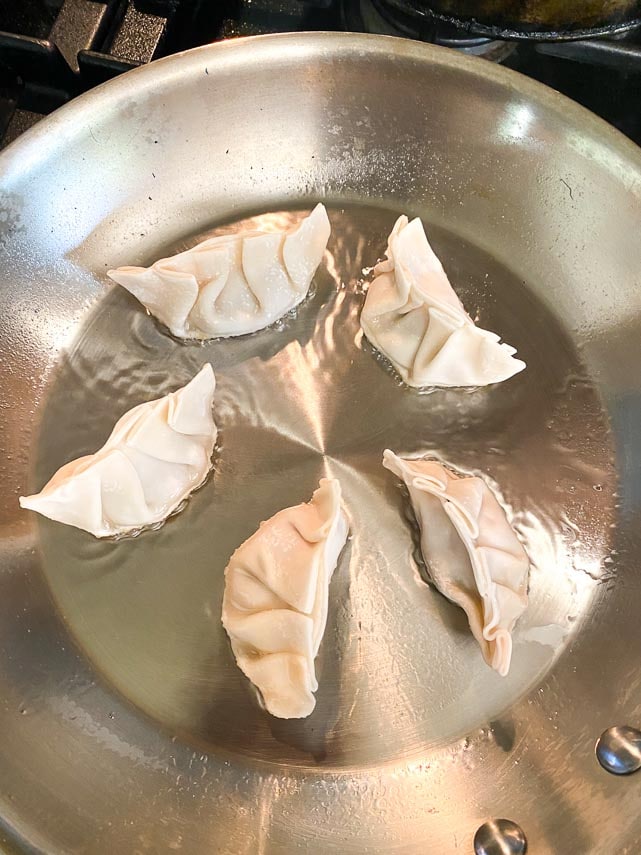
Cook until the bottoms have turned brown and golden, shaking pan occasionally.
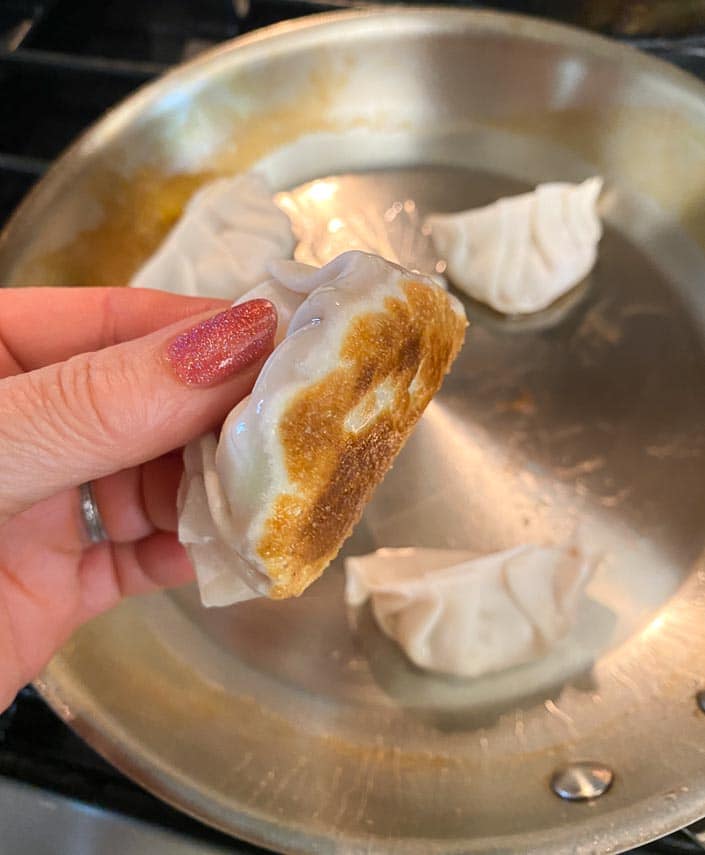
Add water to about the depth of ¼-inch (6 mm) to the skillet and watch out as it will immediately create steam and bubble up; immediately cover.
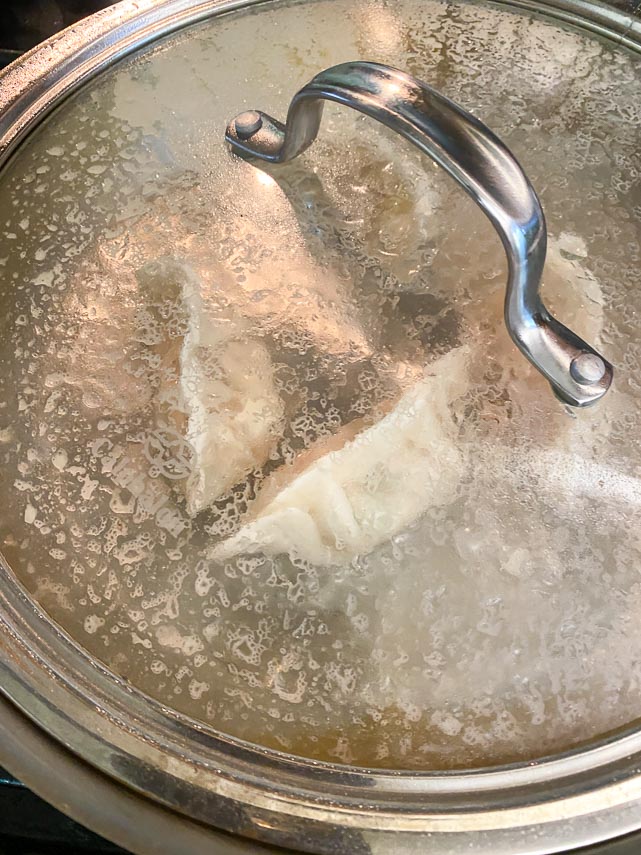
Keep cooking for a few minutes, shaking the pan a few times, until the dumplings are translucent. The water should be mostly evaporated. Uncover and shake the pan a few times and allow the heat to dissipate the water completely. Serve immediately with Dipping Sauce.
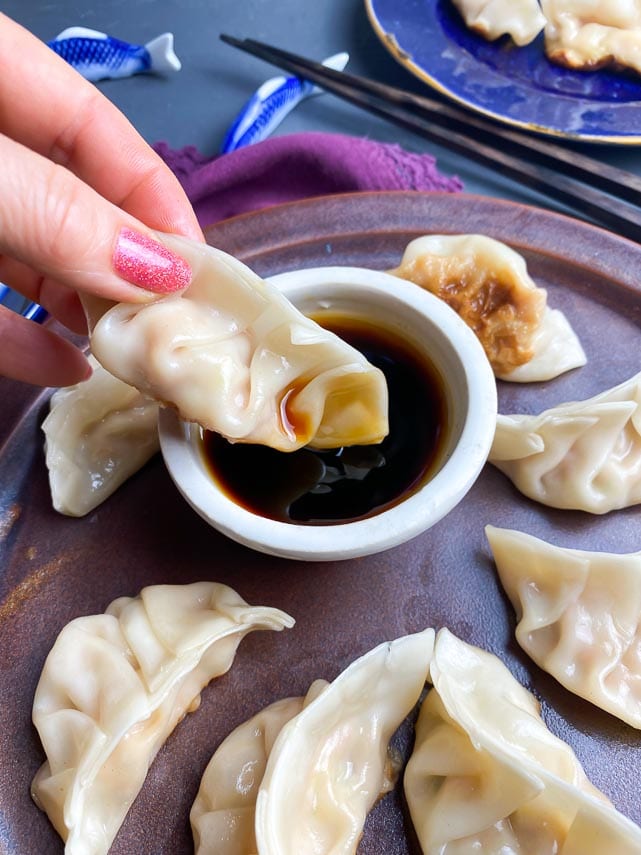
FODMAP Information
Our recipes are based on Monash University and FODMAP Friendly science.
- Cabbage: Both Monash University and FODMAP Friendly have lab tested various cabbages and reported their low FODMAP serving sizes. According to Monash Green Cabbage is low FODMAP in amounts of 75 g (¾ cup) and Red cabbage is low FODMAP in amounts of 75 g (¾ cup). According to Monash Savoy cabbage is low FODMAP in amounts of 40 g (½ cup). According to FODMAP Friendly Savoy cabbage is low FODMAP in amounts of 75 g (1 cup). According to both Monash and FODMAP Friendly, Napa cabbage is low FODMAP in amounts of 75 g (1 cup).
- Ginger: Monash University has lab tested fresh ginger root and has determined it to be free of FODMAPs, making it one of our go-to no FODMAP foods.
- Oil: All pure oils are fats and contain no carbohydrates, therefore they contain no FODMAPs.
- Scallions: The green parts of scallions are low FODMAP as determined by Monash University lab testing and can be used to add onion flavor to your low FODMAP cooking.
- Sugar: Monash University and FODMAP Friendly have both lab tested white, granulated sugar. Monash states that a Green Light low FODMAP serving size of white sugar is ¼ cup (50 g). FODMAP Friendly simply states that they have tested 1 tablespoon and that it is low FODMAP. Regular granulated white sugar is sucrose, which is a disaccharide made up of equal parts glucose and fructose. Sucrose is broken down and absorbed efficiently in the small intestine.
- Vinegar: Several vinegars have been lab tested by both Monash and FODMAP Friendly. From Monash: Apple cider vinegar is low FODMAP at 2 Australian tablespoons or 42 g; Balsamic vinegar is low FODMAP at 1 Australian tablespoons or 21 g; Malt vinegar contains no FODMAPs; Rice wine vinegar is low FODMAP at 2 Australian tablespoons or 42 g. From FODMAP Friendly: Balsamic gets a “Pass” at 2.5 tablespoons or 42 ml. Apple cider vinegar gets a “Pass” at 1 tablespoon or 14 g (don’t ask me why one is in milliliters and the other in grams).
Please always refer to the Monash University & FODMAP Friendly smartphone apps for the most up-to-date lab tested information. As always, your tolerance is what counts; please eat accordingly. The ultimate goal of the low FODMAP diet is to eat as broadly as possible, without triggering symptoms, for the healthiest microbiome.
If you like Asian-style dishes, make sure to check out our Low FODMAP Hot and Sour Shrimp Lo Mein, Low FODMAP Asian Tofu Noodle Papaya Salad, Low FODMAP Asian Steak & Noodle Salad with Mint & Peanuts, Noodles with Shrimp & Broccoli, Pad See Ew, and our Garlicky Peanut Sauce, which we think goes wonderfully with just about anything.
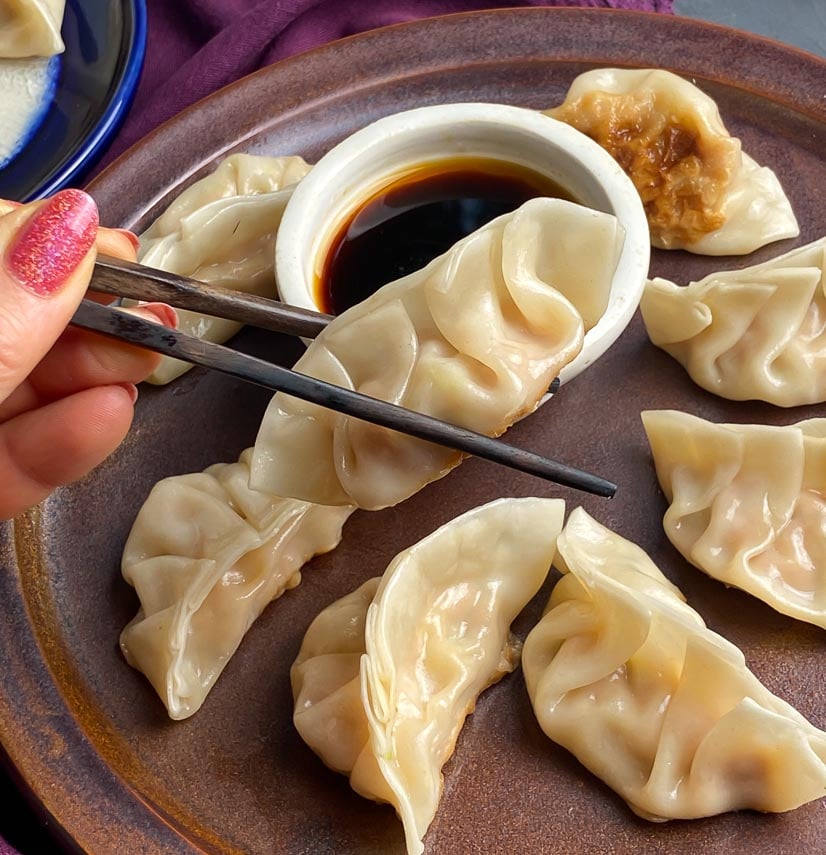
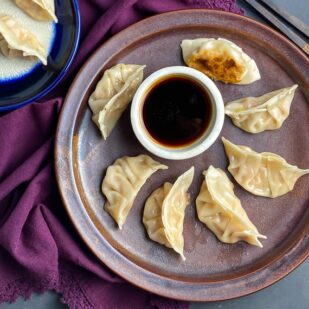
Low FODMAP Pork Dumplings
Whether you call them Low FODMAP Pork Dumplings or pot stickers, this classic Chinese appetizer CAN fit into your low FODMAP lifestyle. Purchased thin wheat flour wrappers are filled with a flavorful pork filling, featuring soy sauce, scallion greens, fresh ginger and toasted sesame oil. Once they are cooked we serve them up with a tangy dipping sauce.
Low FODMAP Serving Size Info: Makes about 50 dumplings; about 12 servings; 4 dumplings per serving
Ingredients:
Dipping Sauce:
- ¼ cup (60 ml) unseasoned rice vinegar
- ¼ cup (60 ml) low-sodium gluten-free soy sauce, such as San J
- ¼ teaspoon FreeFod Garlic Replacer; optional
- ¼ teaspoon sugar;
- 1 teaspoon toasted sesame oil
- Chili oil to taste
Dumplings:
- 1- pound (455 g) ground pork
- 12- ounces (340 g) very finely shredded Chinese cabbage (also called Wombok or Napa)
- ½ cup (32 g) thinly sliced scallions, green parts only
- 3 tablespoons low-sodium gluten-free soy sauce, such as San J
- 2 tablespoons toasted sesame oil
- 1 tablespoon very finely minced fresh ginger
- ¼ teaspoon kosher salt
- 1 large egg
- 50 round dumpling, wonton, or gyoza wrappers
- Neutral vegetable oil
- Water
Preparation:
-
For The Dipping Sauce: In a small nonreactive bowl whisk together the rice vinegar, soy sauce and FreeFod Garlic Replacer and sugar, if using. Once the Replacer and sugar are dissolved, whisk in the toasted sesame oil and chili oil to taste, again, if using. Taste and adjust amounts of ingredients as desired. Sauce is ready to use or may be stored at room temperature in an airtight container overnight.
-
For The Dumplings: In a large bowl, combine the pork, cabbage, scallion greens, soy sauce, toasted sesame oil, ginger, salt and egg until very well mixed. Use your hands to make sure the mixture is very well combined.
-
Create your dumpling making station with your filling, water and dumpling skins nearby. Have a damp cloth over the dumpling skins (or plastic wrap) to keep them from drying out as you make your dumplings.
-
Place about 2 teaspoons of pork filling onto the center each wonton skin. Moisten edges of dumpling skin with water. You can use your fingertip dipped in water, or use a small brush.
-
Fold dumpling skin edges over to form a half-moon shape. You can either press firmly to seal, or gently pleat. NOTE: You do not have to get fancy and pleat! You CAN simply press the edges together and be done with it. Easy! The most important thing is that the two halves are sealed well together, pleats or not.
-
If you want to pleat, there are many approaches to take; I will describe two.
-
The One Directional Pleat: This is where pleats go all the way across the crescent shape, folding and pleating in one direction. Hold the dumpling in front of you with the two halves folded to make a taco shape, but in this case you have not pinched and sealed any parts yet. Then, focusing on the side of the dumpling near you, begin on the left side and pinch the very edge together. Then make one small pleat, folding the wrapper onto itself towards the left. Continue moving across the wrapper, keep making pleats, all facing that left direction. Note that some folks like to pleat to the right, and also some folks find it easier to pleat the edge that is on the backside of the dumpling. Do whatever you need to do that feels easiest. You will probably get about 5 or 6 pleats total. Make sure to pinch the ends closed when finished pleating.
-
The Two Directional Pleat: This is where pleats fold in from the left and the right for a symmetrical, but more complex look. Hold the dumpling in front of you with the two halves folded to make a taco shape and pinch the center together to create stability.
-
Then, focusing on the side of the dumpling near you, begin to the left of the center pinch and create pleats folding and pleating towards the middle and keep working your pleats moving towards the left end of the dumpling. When you get to the left end you can simply pinch together or make one last tiny pleat. Repeat by making pleats on the right side, going towards the center. You will get 3 or 4 pleats on each side. Give all the pleats one last firm squeeze.
-
When your dumplings are all filled you can place them on a pan in a single layer and freeze. Once frozen they can be popped into zip-top bags or airtight containers and frozen for up to 2 months. You can proceed and cook them as described below from frozen; the cooking time might just be a tad longer.
-
You can boil, steam or pan-fry the dumplings.
-
To Steam Dumplings: Set up a covered bamboo steamer over boiling water. Cut a piece of parchment paper to fit, then line the inside of the steamer. You can also lay a large cabbage leaf down instead of the paper. Place dumplings on paper/cabbage leaf. Steam for about 10 minutes or until they look a bit translucent. Serve immediately with Dipping Sauce.
-
To Boil Dumplings: Bring a pot of water to a boil, drop the dumplings in, allowing room for them to move around, and cook for about 3 minutes or until translucent and they float to the top. Drain, dab on a layer of paper towels to absorb excess water. Serve immediately with Dipping Sauce.
-
To Pan Fry Dumplings: Add enough vegetable oil to just cover and create a thin film over the bottom of a skillet (I have successfully used nonstick, triple-ply stainless and cast-iron). Heat over medium heat until oil is shimmering then add as many dumplings – fat, broad side down – as will fit allowing ample room between. Cook until the bottoms have turned brown and golden, shaking pan occasionally. Add water to about the depth of ¼-inch (6 mm) to the skillet and watch out as it will immediately create steam and bubble up; immediately cover. Keep cooking for a few minutes, shaking the pan a few times, until the dumplings are translucent. The water should be mostly evaporated. Uncover and shake the pan a few times and allow the heat to dissipate the water completely. Serve immediately with Dipping Sauce.
Dédé’s Quick Recipe Tips Video
Notes:
FODMAP Information
Our recipes are based on Monash University and FODMAP Friendly science.
• Cabbage: Both Monash University and FODMAP Friendly have lab tested various cabbages and reported their low FODMAP serving sizes. According to Monash Green Cabbage is low FODMAP in amounts of 75 g (¾ cup) and Red cabbage is low FODMAP in amounts of 75 g (¾ cup). According to Monash Savoy cabbage is low FODMAP in amounts of 40 g (½ cup). According to FODMAP Friendly Savoy cabbage is low FODMAP in amounts of 75 g (1 cup). According to both Monash and FODMAP Friendly, Napa cabbage is low FODMAP in amounts of 75 g (1 cup).
• Ginger: Monash University has lab tested fresh ginger root and has determined it to be free of FODMAPs, making it one of our go-to no FODMAP foods.
• Oil: All pure oils are fats and contain no carbohydrates, therefore they contain no FODMAPs.
• Scallions: The green parts of scallions are low FODMAP as determined by Monash University lab testing and can be used to add onion flavor to your low FODMAP cooking.
• Sugar: Monash University and FODMAP Friendly have both lab tested white, granulated sugar. Monash states that a Green Light low FODMAP serving size of white sugar is ¼ cup (50 g). FODMAP Friendly simply states that they have tested 1 tablespoon and that it is low FODMAP. Regular granulated white sugar is sucrose, which is a disaccharide made up of equal parts glucose and fructose. Sucrose is broken down and absorbed efficiently in the small intestine.
• Vinegar: Several vinegars have been lab tested by both Monash and FODMAP Friendly. From Monash: Apple cider vinegar is low FODMAP at 2 Australian tablespoons or 42 g; Balsamic vinegar is low FODMAP at 1 Australian tablespoons or 21 g; Malt vinegar contains no FODMAPs; Rice wine vinegar is low FODMAP at 2 Australian tablespoons or 42 g. From FODMAP Friendly: Balsamic gets a “Pass” at 2.5 tablespoons or 42 ml. Apple cider vinegar gets a “Pass” at 1 tablespoon or 14 g (don’t ask me why one is in milliliters and the other in grams).
Please always refer to the Monash University & FODMAP Friendly smartphone apps for the most up-to-date lab tested information. As always, your tolerance is what counts; please eat accordingly. The ultimate goal of the low FODMAP diet is to eat as broadly as possible, without triggering symptoms, for the healthiest microbiome.
Nutrition
All nutritional information is based on third-party calculations and should be considered estimates. Actual nutritional content will vary with brands used, measuring methods, portion sizes and more. For a more detailed explanation, please read our article Understanding The Nutrition Panel Within Our Recipes.
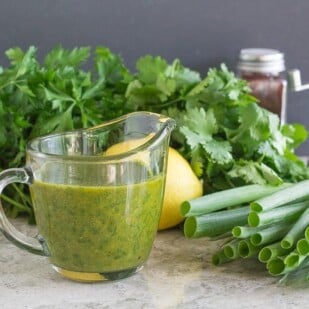
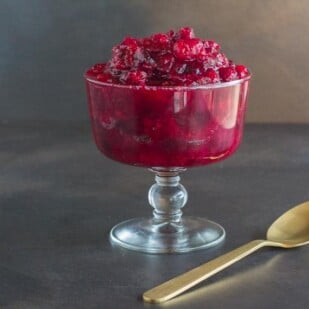






Super good. I also have an allium intolerance and these are great even without the garlic replacer and scallions! The only things I would recommend are to up the ratio of soy sauce to vinegar in the sauce (it was a little too heavy on the vinegar) and add a little more sugar.
So happy to hear that you made them and figured out the low FODMAP tweaks that you needed!
I can’t eat any amount of gluten. I am 100% gluten intolerant. So I can only cry when I see a recipe for dumplings. So, enjoy them for me. I don’t crave anything with gluten anymore. My husband buys Costco dumplings, and I don’t even get a twinge of wanting them.
Oh Alene, we don’t mean to tease you! Have you looked at some of the gluten-free dumplings on the market?
Look up rice paper dumplings!
#celiac